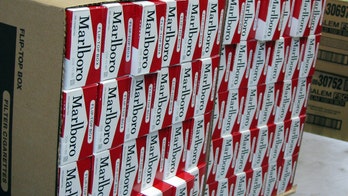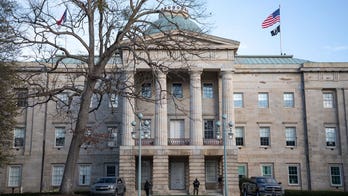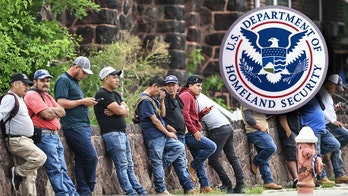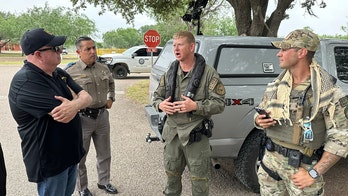At moments like these, the brain works Socratically. It's a process of elimination.
The brain introduces plausible justifications of what's just happened. And one defaults to either yes or no, rapidly considering each scenario.
It first ticks off mundane possibilities.
But when those garden variety reasons don't add up, the mind spirals into spine-chilling territory, presenting a slate of conceivable but alarming explanations.
And if you lived in Washington, DC or New York on September 11, the mind can careen to that frightening menu of interpretations pretty quickly.
On Tuesday afternoon, I had just returned to my office on the third floor of the U.S. Capitol after a series of meetings in the Cannon and Longworth House Office Buildings across the street. I sat down at my desk to devour a salad.
And then I heard it.
At first, I thought it had something to do with a nearby bank of Capitol elevators.
A trio of elevators run just a few feet from the FOX News booth on the House side of the Capitol, close to the House floor.
But this noise....this "commotion" didn't seem right.
I had never heard anything like this from those elevators all the way back in my booth.
So my mind raced through the tree of logical explanations.
Surely it was one of those gigantic bins that workers wheel all over the Capitol. They haul everything from the mail to construction equipment. And they make an awful noise as they roll across the marble floors and echo through the corridors.
But that wasn't it, either.
Could workers be moving something around up above?
There's a crawlspace in between the false ceiling in my booth and the true ceiling. The new House Radio-TV Gallery is only a year old. And shortly after we moved in, workers were always rooting around up there, dragging cables and working on electrical fixtures.
But that wasn't it.
This shook.
This rumbled.
Low and deep.
And it moved the building.
The U.S. Capitol spans 751 feet in one direction and 350 the other, packed with 540 rooms. It's a big, solid place.
But something gave it a jolt.
It felt and sounded like there was a gigantic animal stirring underneath the Capitol, awakening from hibernation.
And what could possibly move the Capitol like that?
Remember, this is Washington, DC. We all lived September 11th.
An explosion? A plane crash?
But even that didn't seem right.
An earthquake?
In Washington.
In the back of my mind, I heard the voice of legendary sportscaster Al Michaels, getting ready for game three of the 1989 World Series at San Francisco's Candlestick Park.
"We're having an earth-....." Michaels said before the network feed cut off.
I ran out to the foyer of the Radio-TV Gallery and met Andy Elias, the gallery's deputy director. I don't even know if I said anything to Andy, I was so incredulous that we may have just experienced an earthquake.
And then the low rumble started again. Low and deep. But more powerful this time.
And longer.
Andy suggested we huddle in the doorjamb.
This wave was stronger. The current moved from north to south, advancing from the Senate side of the building to the House side.
But an earthquake? Here?
I needed to get outside. And needed to let FOX know that the United States Capitol was shaking.
I dashed into the hall and raced down one of the building's four grand staircases. Police officers ran everywhere.
No one had to be told to get out.
I got through to FOX on the second try, still not fully processing what was going on. The line died as I exited the south door of the Capitol and joined a mass of Congressional staffers, spilling out onto the lawn.
"When in doubt, leave it out."
That's the old dictum in journalism.
Was it an earthquake? I don't know. I'm a Midwesterner. Never been through one of these. I understand tornadoes. Was this a bomb? Or something even bigger?
No pillar of smoke rose from the Capitol. It seemed like an earthquake. But no one really knew.
I hastily dashed off a mass email to FOX.
Stick to what you know.
"Shockwave rocks Capitol."
Most people appeared calm. The evacuation was rote.
It's become all too familiar around here. At the Capitol, we get air incursions when a plane wanders into Washington's restricted air space. We get suspicious packages. We get suspicious substances. Even good, old-fashioned fires once in a while. So everyone exits the building in a very orderly fashion. Just like they implore you to do for a fire drill in first grade.
Emails kept coming. They felt this in New York. And Canada! Ok. Sounds like an earthquake. A BIG earthquake And then the emails started asking people to dial in to the control rooms at FOX in New York. But now I couldn't get through on any of the numbers.
Maybe it was my phone.
That's when I spotted Amy Swisher Lozupone, an aide to House Speaker John Boehner (R-OH). She was on her BlackBerry talking to someone. So I asked Lozupone if I could try on her phone after she hung up.
We tried to get through. But to no avail.
I learned one of my most important lessons about journalism long before I ever became a journalist.
James M. Cox was born directly across the road from where I grew up in Jacksonburg, OH. Cox was a Congressman, served as Ohio's governor and then earned the Democratic nomination for president in 1920.
But before Cox got into politics, he was a journalist. And a crafty one at that. His legacy today is Cox Newspapers and Cox Broadcasting.
As a kid, I learned that when Cox was a young reporter, his editor dispatched him to the site of a terrible train crash. When Cox arrived in the town of the crash, he first went to the local telegraph office rather than to the scene of the accident. He immediately asked the telegraph operator to begin transcribing the Bible. Cox then headed out to the train crash.
At the time, telegraph law dictated that once a message was started, it could not be interrupted. Cox later returned to the telegraph office and transmitted his story. He scooped his reporting colleagues as they had to wait for Cox to yield the line.
So I immediately began wondering where I could get a hard line. The Library of Congress was right behind me. But now it was closed off. I thought of friends who lived on Capitol Hill. But who knew where they were. I wondered about local pubs like Tortilla Coast and Bullfeathers.
And then I thought of St. Peter's church, located just steps from the Cannon House Office Building and behind one of the Library of Congress Buildings. If I could get to an open phone line, I could call in details.
I took off in a sprint.
Arriving at St. Peter's, I discovered that the quake shook loose some sizable chunks of bricks and mortar from the church. A stone cross was perched at the top of the building, above the main entrance. The quake broke the cross free and it plunged to the ground, pulverized by concrete steps below. I then discovered Lynn Freeman, the rectory manager, standing in the doorway. I introduced myself and asked if I could use her phone. Freeman was happy to help and showed me to her office. That's where I first dialed into the FOX Business Network for a couple of hits, then FOX News and two sessions with FOX News Radio.
Had it not been for the kindness of Freeman, who knows how I would have gotten through. She even offered me a glass of water as sweat dripped off my forehead and onto my notes as I sat at her desk.
I then asked Freeman if I could check out the scene and return to use the line again (an old James M. Cox trick). Freeman was happy to oblige. I owe her and St. Peter's big time.
The U.S. Capitol Police gradually re-opened various buildings of the Capitol complex over the next several hours. One could spot a few splotches of plaster, paint and tile that cascaded from the ceiling of the Capitol Rotunda and littered the floor. Most of the debris fell on the southwest side, pock marking the floor between the statues of Alexander Hamilton and Ulysses Grant. Some plaster also broke free in Statuary Hall, the old House chamber.
The damage was minimal. People soon realized the quake wasn't catastrophic. But the traffic was awful. Police still had the Capitol garages locked down. And many Congressional staffers couldn't even return to their offices to retrieve their things until structural assessments were complete late Tuesday evening.
The brain works Socratically. It's a process of elimination. It ticks through a litany of possibilities as to what to do.
So the aides couldn't go home. They couldn't go back to their offices. So many members of the Congressional tribe began exploring their options.
In this case, the options were called Lounge 201, Hawk ‘n' Dove and The Dubliner.
Just a few of Capitol Hill's many watering holes.




